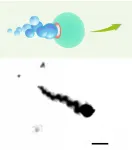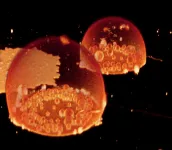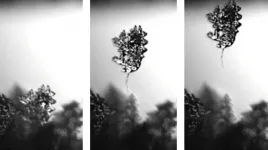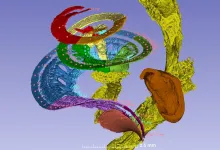New vaccine needed for serious childhood pneumonia
2021-02-24
(Press-News.org) A UNSW Sydney-led medical research team has called for a new vaccine, improved strategies and enhanced monitoring to combat serious complications from childhood pneumonia.
The researchers examined the impact of the 13-valent pneumococcal conjugate vaccine (13vPCV) on childhood pneumonia and empyema - complicated pneumonia - after its introduction to the Australian National Immunisation Program about a decade ago.
The new study, published in Thorax recently, found that while 13vPCV resulted in a 21 per cent decrease in childhood pneumonia hospitalisations, there was a contemporaneous 25 per cent increase in admissions for empyema.
This incidence data for childhood empyema hospitalisations is similar to that reported in other countries.
Approximately 7000 Australians under the age of 18 are hospitalised with pneumonia each year.
Senior author Professor Adam Jaffe, Head of the School of Women's and Children's Health at UNSW Medicine & Health, said the researchers' findings suggested an emergence of non-vaccine serotypes - those which 13vPCV does not cover.
13vPCV was introduced to cover the 13 most common serotypes responsible for invasive pneumococcal infection, extending coverage to six additional serotypes including 1 and 3.
The previous vaccine (7vPCV) covered seven serotypes. A serotype is a distinct variation within a bacteria species.
Prof. Jaffe said: "Although we found a substantial reduction in serotype 1, serotype 3 is now the predominant organism which causes childhood empyema - in 76 per cent of cases - so, efforts must be made to create a vaccine which is more effective against serotype 3.
"In fact, Australia recently changed the vaccination dosage schedule to try and improve the effectiveness of 13vPCV against serotype 3, but we need to continue monitoring patients using molecular techniques to see if this change has had an impact.
"Childhood bacterial pneumonia and empyema are potentially preventable diseases through vaccination. So, if Australia can develop an effective vaccine, we could prevent children from being hospitalised with pneumonia and empyema."
Empyema is infected fluid around the lungs and about one per cent of children hospitalised with pneumonia develop it.
Although children are highly unlikely to die from empyema, they can expect a long stay in hospital for treatment with antibiotics and surgery, or the insertion of a drain. If adults develop empyema, about a third are likely to die.
Continuing enhanced surveillance needed
The researchers conducted a similar study during the period of the superseded 7vPCV. Their new study - which took four years to complete - is part of a broader research project on 13vPCV.
"Our new study had two parts," Prof. Jaffe said. "We analysed national hospitalisations for childhood empyema and childhood pneumonia, then we conducted an enhanced surveillance study on children with empyema."
The first part of the research used publicly available hospitalisations data - about 36,000 admissions - to assess whether the introduction of 13vPCV changed how many children were admitted to hospital with pneumonia and empyema.
The enhanced surveillance study involved the collection of blood and lung fluid samples from 401 children with empyema from February 2015 to September 2018.
The children were receiving treatment in 11 major children's hospitals across Australia.
Most children were boys (208 or 52 per cent) and the median age was four years old.
The researchers then conducted molecular testing on these samples and compared the results to their previous study undertaken during the period of 7vPCV.
The multidisciplinary team included Dr Nusrat Homaira, of the Discipline of Paediatrics at UNSW Medicine & Health, and paediatric research nurse Roxanne Strachan of Sydney Children's Hospital.
Prof. Jaffe said: "Our new research is the first of its kind in Australia - so, we now have the best data available for complicated childhood pneumonia to help guide future vaccination introductions and improve vaccine strategies.
"We are currently working on our larger study, of which this was a subset, to examine the effectiveness of 13vPCV on children with bacterial pneumonia. We will need to repeat the study in a few years' time to help with monitoring.
"In the meantime, it would make a big difference if molecular testing of patients' lung fluid was routine in laboratories, because that would ensure we had the best real-time data available which will help rationalise antibiotic choice; also, we would have no need to seek funding to undertake this much-needed research."
INFORMATION:
Find the study in Thorax: http://dx.doi.org/10.1136/thoraxjnl-2020-216032
ELSE PRESS RELEASES FROM THIS DATE:
2021-02-24
For many, 2020 was notorious for the COVID-19 pandemic, but for climate scientists, the year is also infamous for tying with 2016 as the hottest since records began. 'Nine of the warmest years on record have occurred since 2010', says JEB Editor-in-Chief, Craig Franklin. With the ice caps and glaciers melting, devastating bushfires scorching arid regions, and hurricanes and typhoons battering coastal communities, the impact on local ecosystems has been catastrophic. 'Physiologists can play a critical role in the conversation around climate change', says ...
2021-02-24
As part of the Journal of Experimental Biology's Special Issue dedicated to climate change, Anthony Pagano (San Diego Zoo Global, USA) and Terrie Williams (University of California, Santa Cruz, USA), discuss the impact of environmental change on two iconic polar species; the polar bear and narwhal. Their review article is published in Journal of Experimental Biology at https://jeb.biologists.org/content/224/Suppl_1.
Mammals in the Polar Regions face an uncertain future as unprecedented warming drives catastrophic sea ice loss, driving polar bears onto land, after losing access to sea ice and ...
2021-02-24
Rheumatoid arthritis is a chronic inflammatory disorder marked by joint pain, swelling and damage. Although medications, such as steroids, anti-inflammatory drugs and immunosuppressants, can help slow joint destruction and relieve pain, they have side effects and aren't completely successful. Now, researchers reporting in ACS' Nano Letters have developed magnesium-based micromotors propelled by hydrogen bubbles, which improved rheumatoid arthritis symptoms when injected into the joints of rats.
Scientists have linked rheumatoid arthritis development to the excess production of reactive oxygen species (ROS). ROS can oxidize and degrade cartilage and bone, as well as activate the expression of inflammatory cytokines. A new type of therapy, hydrogen gas, can neutralize ROS ...
2021-02-24
To come into being, galaxies need a steady diet of cold gases to undergo gravitational collapse. The larger the galaxy, the more cold gas it needs to coalesce and to grow.
Massive galaxies found in the early universe needed a lot of cold gas--a store totaling as much as 100 billion times the mass of our sun.
But where did these early, super-sized galaxies get that much cold gas when they were hemmed in by hotter surroundings?
In a new study, astronomers led by the University of Iowa report direct, observational evidence of streams of cold gas they believe provisioned these early, massive galaxies. They detected cold gas pipelines that knifed through the hot atmosphere in the dark matter halo of an early massive galaxy, supplying the materials ...
2021-02-24
New research by the University of Oslo provides evidence that the "protocells" that formed around 3.8 billion years ago, before bacteria and single-celled organisms, could have had specialized bubble-like compartments that formed spontaneously, encapsulated small molecules, and formed "daughter" protocells.
ROCKVILLE, MD - Scientists have long speculated about the features that our long-ago single-celled ancestors might have had, and the order in which those features came about. Bubble-like compartments are a hallmark of the superkingdom to which we, and many other species including yeast, belong. But the cells in today's superkingdom have a host of specialized molecules that help make and shape these bubbles inside our ...
2021-02-24
ATLANTA - FEBRUARY 24, 2021 - New study reports that early in the 2020 pandemic in the United States, one-third of cancer survivors worried about treatment and cancer care disruptions. Using a mixed methods approach, investigators utilized survivors' own words to more deeply describe their experiences and worries about the pandemic's impact on their overall health.
The article, appearing in the Journal of Psychosocial Oncology, finds the impact of the pandemic on cancer survivors and the broader health care system is widespread and exacerbated serious gaps in the health care system. For this study, investigators led by Corinne Leach, MPH, MS, PhD, from the American ...
2021-02-24
If you have ever gotten up on a winter morning and thrown yourself into the arduous task of scraping frost from a windshield, a Virginia Tech lab is engaging science [IS1] that could make your life much easier. In research funded by the National Science Foundation, Associate Professor END ...
2021-02-24
DALLAS, Feb. 24, 2021 -- Postmenopausal women who ate high levels of plant protein had lower risks of premature death, cardiovascular disease and dementia-related death compared with women who ate less plant proteins, according to new research published today in the Journal of the American Heart Association, an open access journal of the American Heart Association.
Previous research has shown an association between diets high in red meat and cardiovascular disease risk, yet the data is sparse and inconclusive about specific types of proteins, the study authors ...
2021-02-24
In the largest genome-wide association study of glaucoma comparing the genes of 34,179 people with the disease to 349,321 control subjects, an international consortium of researchers identified 44 new gene loci and confirmed 83 previously reported loci linked to glaucoma. Loci are considered "genetic street addresses," denoting a specific location on a gene.
The study's authors hope the identification of these genes will lead to new treatment targets for this incurable eye disease that is a leading cause of blindness worldwide.
"These new findings come out of the highest-powered genome-wide association study of glaucoma to date, and show the power of team science and using big data to answer questions when research groups around the world join forces," said co-senior study author ...
2021-02-24
Peer review/Experimental study/Cells
Researchers at Uppsala University have created the first 3D map of the hearing nerve showing where the various sound frequencies are captured. Using what is known as synchrotron X-ray imaging, they were able to trace the fine nerve threads and the vibrating auditory organ, the cochlea, and find out exactly how the frequencies of incoming sound are distributed. The study is published in Scientific Reports.
"This can make treatment with cochlea implants for the hearing-impaired more effective," says Helge Rask-Andersen, Professor of Experimental Otology at Uppsala ...
LAST 30 PRESS RELEASES:
[Press-News.org] New vaccine needed for serious childhood pneumonia




